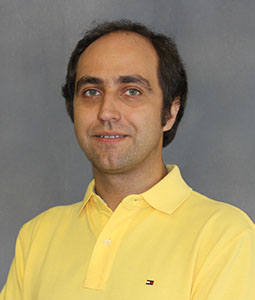Department of Chemistry and Biochemistry
Faculty and Staff Directory
Dmitry V. Peryshkov
| Title: | Associate Professor / Inorganic Catalysis / Materials / Organometallic |
| Department: | Chemistry and Biochemistry McCausland College of Arts and Sciences |
| Email: | peryshkov@sc.edu |
| Phone: | 803-777-6414 |
| Fax: | 803-777-9521 |
| Office: | Office: GSRC 510 Lab: GSRC 406, 803-777-2334 |
| Resources: | CV [pdf] All Publications Dmitry Peryshkov Group Website Department of Chemistry and Biochemistry |

Education
B.S., 2004, Moscow State University
M.S., 2004, Moscow State University
Ph.D., 2011, Colorado State University
Honors and Awards
McCausland Faculty Fellowship, 2025
Breakthrough Star Award, 2018
National Science Foundation CAREER Award, 2017
Doctoral New Investigator Award, ACS PRF, 2014
Research Interests
Research areas: Inorganic chemistry and catalysis, organometallics, main group chemistry, metal-free
bond activation.
Research in the group involves the synthesis of molecular catalysts for activation
of important substrates such as dihydrogen, carbon dioxide, and unsaturated organic
compounds. Students with interest in catalysis, inorganic, and organometallic chemistry
are encouraged to join. Group members will receive a rigorous training in inorganic
and organometallic chemistry, catalysis, air-free synthetic methods, and spectroscopic
methods.
Metal-free Bond Activation by Redox-Active Main-Group Systems
We have harnessed redox-activity of boron clusters for the cage-driven activation
of strong bonds at exohedral reaction centers. We design new metal-free molecular
frameworks containing redox-active metal-free fragments with two critical features
typically associated with transition metals: binding sites and the ability to cycle
through two-electron redox states.
Catalysis with Multimetallic Transition Metal Complexes Supported by Main-Group Ligands
Transition metal complexes with new unusual bonding and reactivity patterns in catalysis
are pursued. We design multidentate main group systems as chemically versatile platforms
for stabilization of reactive transition metal complexes for small molecule activation
and group transfer.
Pre-Organized Lewis Pairs for Small Molecule Activation
We work on new modes of activation of organic substrates by a cooperative action of
high-valent transition metal complexes and sterically hindered bases. Our recent findings
include the novel activation of nitriles with direct formation of zwitterionic vinylimido
complexes. The scope of the reaction includes a range of substituted unactivated nitriles.
Publications
Riffle, J. R.; Jowers, C. L.; Luna, S.; Smith, M. D.; Peryshkov, D. V. Non-spectator Behavior of a Neutral Phosphine Ligand Driven by a Redox-Active Boron Cluster, Chemical Science, 2025 DOI: 10.1039/D5SC04058B
Humphries, A. L.; Tellier, G. A.; Smith, M. D.; Chianese, A. R.; Peryshkov, D. V.
N–H Bond Activation of Ammonia by a Redox-Active Carboranyl Diphosphine, Journal of the American Chemical Society, 2024, DOI:10.1021/jacs.4c12146
Nussbaum, B. C; Cavicchi, C. R.; Smith, M. D.; Pellechia, P. J.; Peryshkov, D. V.
Redox- Active Carboranyl Diphosphine as an Electron and Proton Transfer Agent. Inorganic Chemistry 2024, DOI: 10.1021/acs.inorgchem.4c02022
Nussbaum, B. C.; Humphries, A. L.; Gange, G. B.; Peryshkov, D. V. Redox-active Carborane
Clusters in Bond Activation Chemistry and Ligand Design. Chemical Communications 2023, DOI: 10.1039/D3CC03011C